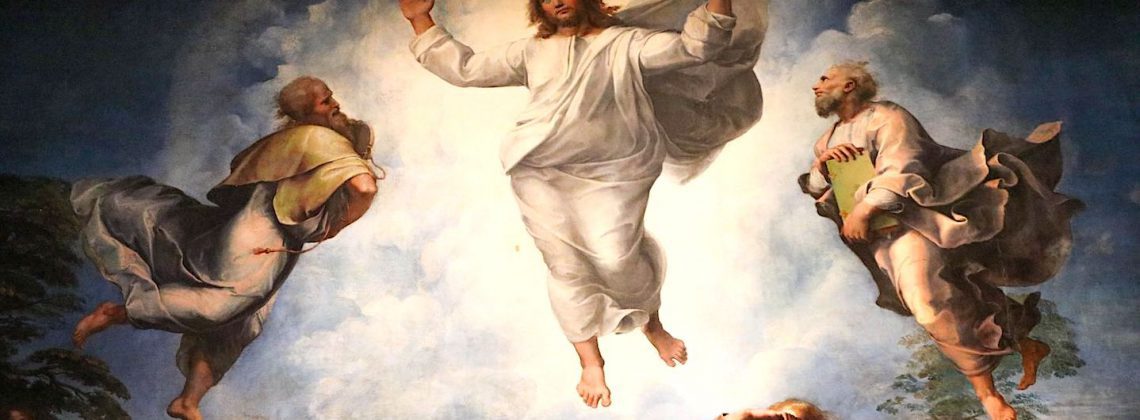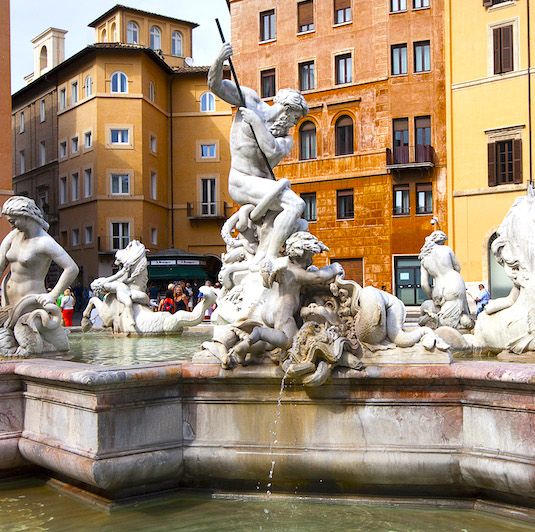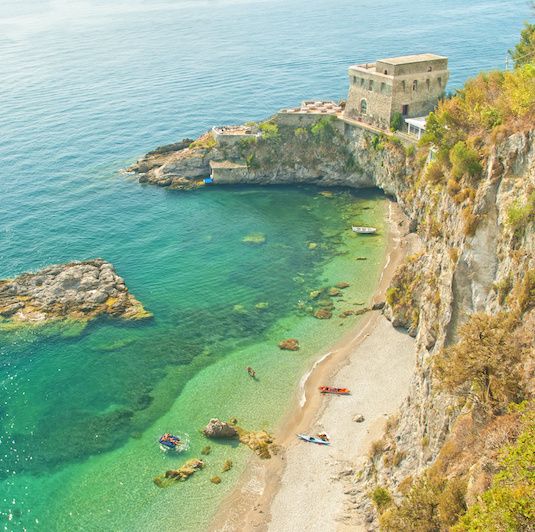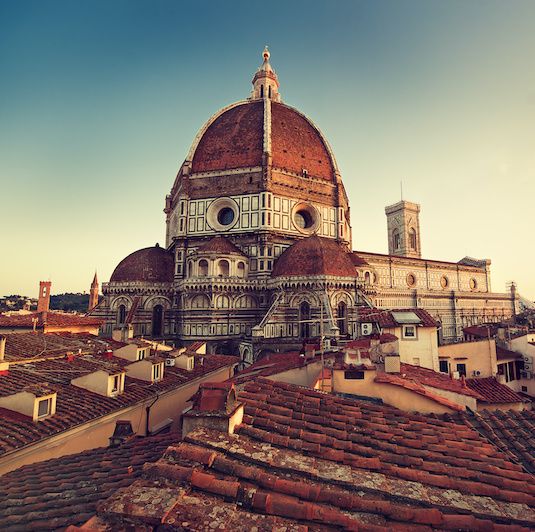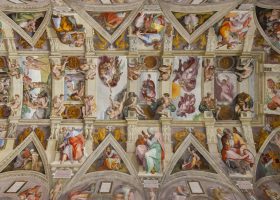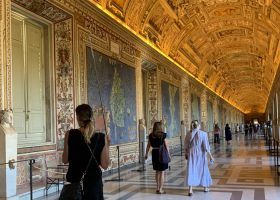Planning to visit the Vatican but unsure what famous artwork you should see? Don’t worry! We’ve run tens of thousands of Vatican tours, which makes us Vatican experts. Here is what we believe is the most famous artwork that you absolutely must see when visiting the Vatican.
Pro Tip: Planning your visit to the Vatican? Bookmark this article in your browser so you can easily find it when you’re in the Museums. It contains tons of information that will elevate your Vatican visit. Also, see our dedicated guide to Vatican City for more planning resources, our top Vatican tours for a memorable trip, and how to visit the Vatican.
The Most Famous Artwork At The Vatican
The Vatican Museums house a huge collection of artworks by some of the most famous and celebrated artists in the world. Aside from the paintings and sculptures in the museums, the Vatican’s rooms and walls are works of art themselves. From the Sistine Chapel to the Rafael Rooms and the works in the Pinacoteca, you’ll discover the most famous artworks at the Vatican.
If you look at a painting and don’t feel anything, you likely haven’t heard its story. This is why we recommend guided tours. An expert art history guide skilled in the art of storytelling will make your visit that much more memorable and you’ll come away with a much deeper appreciation for the art. That’s what we do!
As you prepare for your Vatican Museums visit, you might also want to check out our ultra-comprehensive list of what to see at the Vatican written by a licensed Vatican guide!
Not ready to book a tour? See if a Vatican tour is worth it.
23. The Victory Of Christianity Over Paganism (Ceiling)
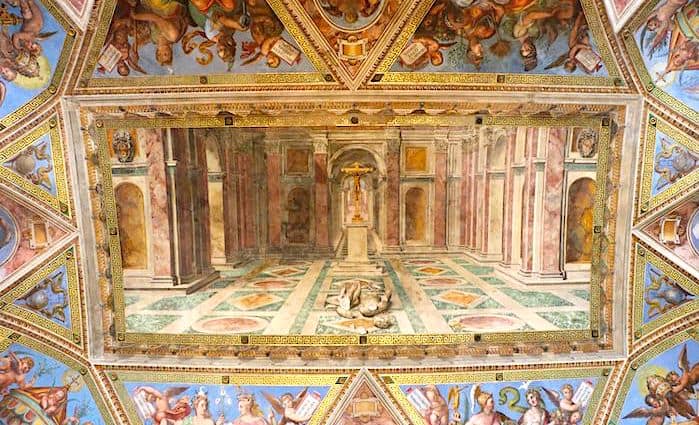
Tommaso Laureti | 1585 | Fresco | Raphael Rooms: Hall of Constantine
Most people miss this jewel of a painting—don’t forget to look up at the ceiling! If ever there was one image to encapsulate the expression “A picture paints a thousand words,” this is the one.
What better way to show one’s triumph over another? You replace the exact thing you triumphed over! Originally, there was a statue of the pagan god Mercury (Greek Hermes) on the pedestal. Replaced by a Christian cross, the previous statue (or symbol) has been crushed to pieces below. There is no truth behind this, but I imagine that this scene actually happened at one point.
I have stared at this painting many times and what never ceases to amaze me is the depth Laureti was able to achieve in the painting. The 3D effect on a 2D form is mesmerizing.
22. The Colossal Statue Of Augustus
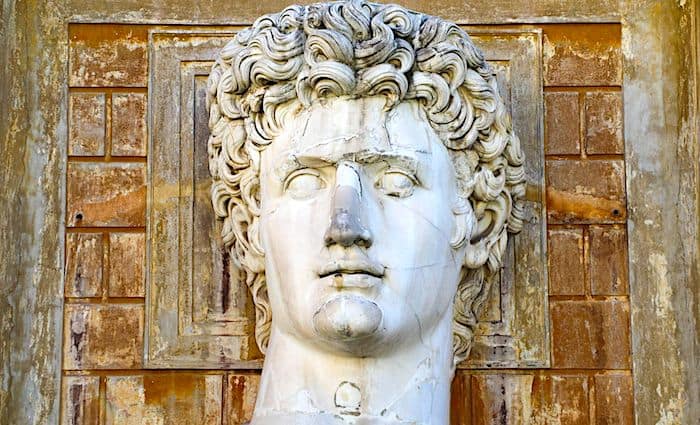
Unknown Artist | Unknown Year | White Marble | Pine Cone Courtyard
Today, Instagram allows us to immortalize ourselves by adding photos for everyone to see. Sculptures were the Instagram of the ancients.
Octavianus Augustus was the first and arguably one of the most important Ancient, Roman Emperors. He created the Pax Romana ( Roman peace) after a century of strife and turmoil. He lived to the ripe, old age of 75 and was also Emperor during the early years of Jesus.
As with Instagram, we tend to show our best side in a photo. Back in the day, even if they were older, they would order a statue to be made of themselves during their youth. The strategy worked, since we can easily recognize a statue of Augustus as a young man, but have no clue what he looked like when he was older!
21. The Borgia Apartments
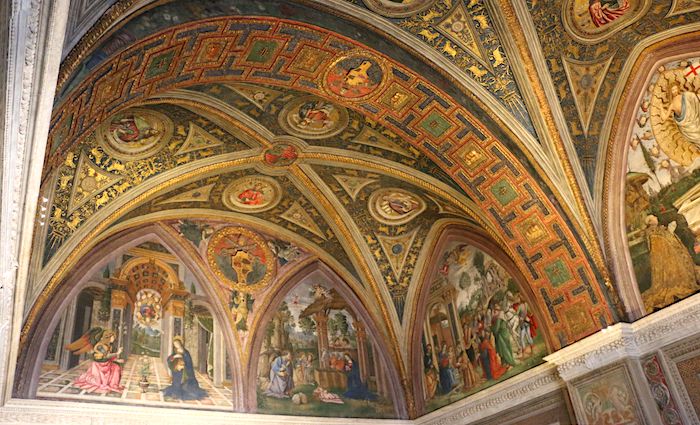
Various Artists | 15th Century | Fresco | Borgia Apartments
The Borgia apartments are the rooms where the Borgia family lived during Alexander VI’s papacy. Pinturicchio painted many of the frescoes, which are beautiful examples of early Renaissance artwork. Take some time and walk through these five rooms in the Vatican.
You’ll notice some of the figures in the paintings have their faces removed. This is because later popes hated the Borgias so much they had their images removed! How is that for erasing someone’s memory?
Find out more about the infamous Borgia, the scandalous events that took place in these apartments, and the top things to see in our article on the Vatican Borgia Apartments.
Alexander VI has remained infamous for his selfish use of the papacy. He had several children and was a more temporal monarch than a spiritual leader. He terrorized cardinals and princes who did not submit to his authority. These rooms witnessed the exploits of Rodrigo Borgia and his children.
Enrico Bruschini, Art Historian and Official Vatican Tour Guide
Popular Vatican Tours
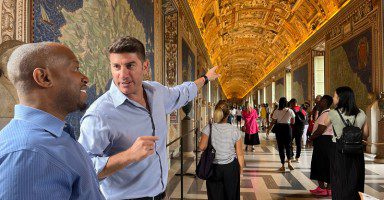
Best Selling Tour
Privileged Entrance Vatican Tour with Sistine Chapel
Without the right access, visiting the Vatican means fighting crowds, long waits, and missing the most significant rooms and works of art. Our privileged entrance tour offers more than just entry—it’s an immersive experience led by a storytelling guide who brings the Vatican to life. Skip the line and explore the Vatican Museums, including the Raphael Rooms, the Sistine Chapel, and St. Peter’s Basilica with engaging insights that make each moment memorable and meaningful.
See Prices
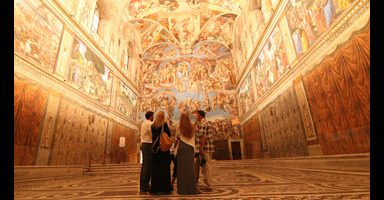
Best Price!
Exclusive Sistine Chapel After Hours Small Group Tour
When the Vatican Museums close to the public, you step inside, with no other groups and no crowds—just you, a handful of others, and Michelangelo’s Sistine Chapel in perfect silence. On this rare after-hours tour, wander the Vatican’s galleries as they were meant to be seen, free from the chaos of the day. With a small group and expert guide, explore the Raphael Rooms, the Gallery of Maps, and the treasures of the Vatican as few ever will.
See Prices
Not ready to book a tour? Check out our best Vatican tours to take and why.
20. St. Jerome (Da Vinci)
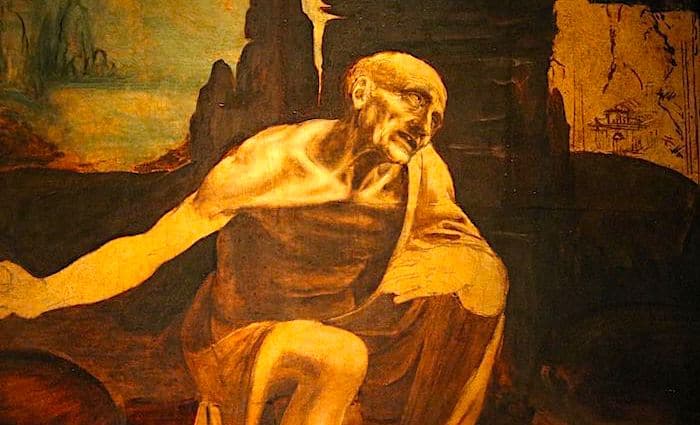
Leonardo Da Vinci | 1482 | Oil on Wood | Pinacoteca Room IX
Da Vinci wasn’t just a master painter but also an engineer, inventor, and even a builder of siege weapons. This is one of the most enigmatic paintings by the master, Da Vinci, and the story behind it is even more intriguing. Da Vinci was known for not finishing many of his commissions. While this art piece is only a sketch, it reveals the genius of the man.
It shows St. Jerome who, for his love of God, lived as an ascetic for many years in the Syrian desert. He is always depicted in an emaciated manner, and this sketch is no different.
Old and bald in the picture, he has the look of a man who has endured serious pain in his life. He’s sitting down with the lion at his feet (his companion after having pulled a thorn from the lion’s foot). Also, he holds a rock in his hand, which he would traditionally use to beat himself on the chest as penance.
The Story Behind St. Jerome
The story is quite fascinating as it appears that it was divided into two pieces. The lower part was found in a second-hand shop where it was used as the cover for a box.
The upper part, with St. Jerome’s head, was found at his shoe maker’s, where it was used as a cover for his stool. Upon his death, it was auctioned and exchanged hands a few times. Pope Pius IX finally bought it in 1856 where it has been ever since.
The sketch became the property of Angelica Kauffmann, a Swiss painter, and was lost at the beginning of the nineteenth century. It was discovered by Cardinal Joseph Fesch, uncle of Emperor Napoleon, cut into two parts and was being used as household scrap wood. It is amazing to think about how many priceless works of art may still be scattered around the world.
Enrico Bruschini, Art Historian and Official Vatican Tour Guide
19. Statue Of Hercules In Bronze
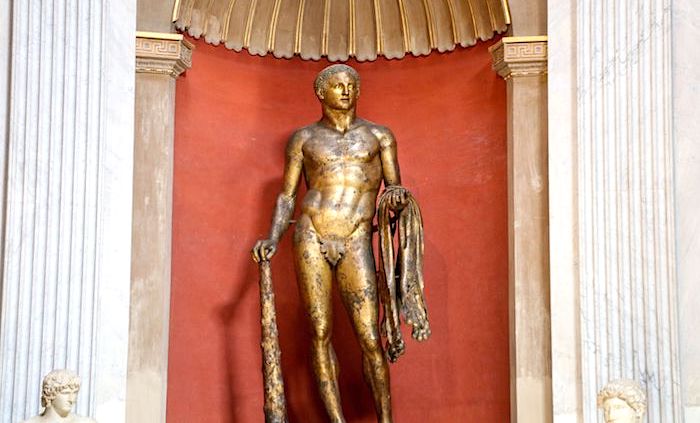
Unknown Artist | First to Third Century A.D. | Bronze | Round Room
Back in the day, the Romans often melted down bronze statues to recycle the metal. So, it’s truly a gift to find an ancient statue in bronze. This gilded Hercules has large staring eyes and curly hair. Archeologists found the statue in 1864 under a courtyard near Campo de’ Fiori not far from the Theater of Pompey where Julius Caesar was assassinated.
The statue was then given to Pope Pius IX (1846-1878) and that’s how it came to be in the Vatican today. It’s easy to identify Hercules due to the Nemean lion skin draped over his arm, the club he rests on, and the apples of the Hesperides in his left hand.
The statue has been dated with a few different dates ranging from the first to the third centuries A.D. Historians point to the style as being copied from the Neo-Attic style of the fourth century B.C.
Interesting Fact
When they found Hercules, it was lying on its back with a slab of travertine stone on top of it like a burial. On top of the slab of stone the following letters were carved: F C S for Fulgur Conditum Summanium.
The statue had been struck by lightning and since Hercules was the son of Zeus, the ancient Romans took that as a sign that the statue should be properly buried together with the remains of a lamb.
18. The Crowning of the Virgin
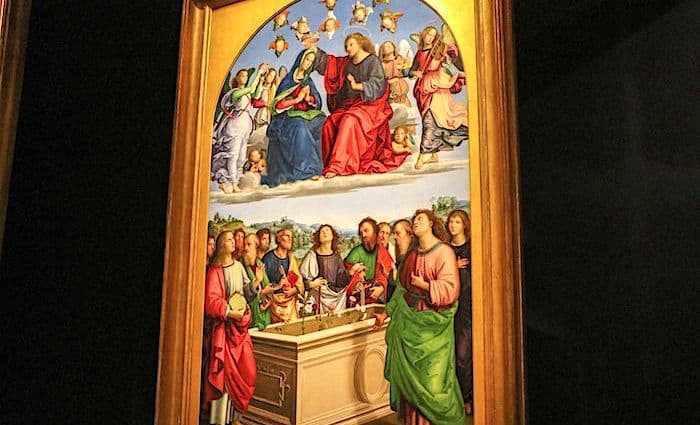
Raphael | 1502-1503 | Tempera on Wood | Pinacoteca Room VIII
When I was 19 years old, I was roaming the bars of Bologna. At the same age, Raphael painted The Crowning of the Virgin. This is one of my personal favorites because of the simple and elegant beauty of the individual figures depicted.
The painting is broken down into two scenes. The bottom half shows the grave where the Virgin Mary was laid to rest with the apostles around her. St. Thomas is holding the girdle, which was given as a gift from the virgin herself.
Where she would have been in the tomb, there are flowers as she had since ascended to heaven. The apostles are all looking in amazement as they see her image above with Jesus.
The upper portion of the painting depicts the Virgin Mary and Jesus, who is crowning her as the blessed mother. There are angels surrounding them and some are even playing musical instruments.
The play on color is similar to the Transfiguration, where the darker colors are below. As your eyes naturally move upwards, the color scheme becomes lighter. The faces show the ideal beauty of man, which is expressed even more so in the angelic face of the Virgin Mary.
17. Artemis Of Ephesus
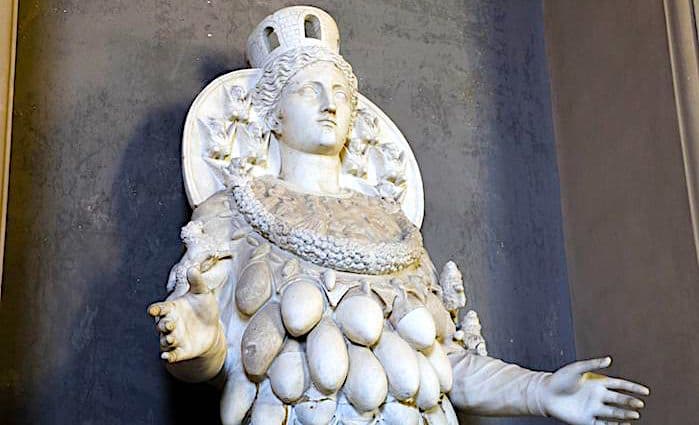
Unknown Artist | Unknown Date | White Marble | Gallery of the Candelabra
This piece is by far the most striking statue in this room and definitely the biggest eye-catcher. Many people will walk past the statue and you’ll hear them say, “Look at the multi-breasted statue!”
Upon closer inspection, you realize that they are, in fact, bull testicles. Considering that Artemis was the goddess of fertility, what symbol resonates more with fertility than bull testicles?
The statue is one of many copies that you’ll find, which would have originated in Ephesus, Asia Minor in modern-day Turkey. Ephesus was a booming port city during the Ancient Roman Empire and even today is a huge archeological park.
The city was dedicated to Artemis and one of the biggest temples in ancient times was the Temple of Artemis. Inside the temple, you would have found statues of Artemis with bull testicles like this one.
Interesting Fact
In the bible, St. Paul goes to Ephesus to preach and is almost violently killed. By who? The merchants of the temple of Artemis made a pretty penny from the sale of statues of the goddess. If there was only one true God, then all the silversmiths and merchants would go out of business.
Popular Rome Tours
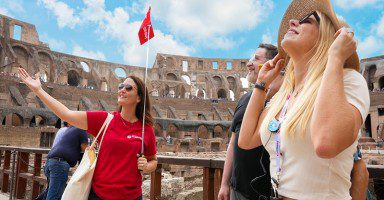
Best Selling Tour
Rome in a Day Tour with Colosseum and Vatican Museums
Seeing the best of Rome in a single day might seem like a big undertaking, but our expertly designed tour makes it effortless with skip-the-line tickets, included transportation, and engaging guides to lead the way. In just 7 hours, you’ll visit renowned sites like the Sistine Chapel, Colosseum, Trevi Fountain, and Pantheon. With fascinating stories at every stop, you can skip the stress and immerse yourself in the vibrant heritage and culture of Rome all in one remarkable day.
See Prices

Best Price!
Privileged Entrance Vatican Tour with Sistine Chapel
Without the right access, visiting the Vatican means fighting crowds, long waits, and missing the most significant rooms and works of art. Our privileged entrance tour offers more than just entry—it’s an immersive experience led by a storytelling guide who brings the Vatican to life. Skip the line and explore the Vatican Museums, including the Raphael Rooms, the Sistine Chapel, and St. Peter’s Basilica with engaging insights that make each moment memorable and meaningful.
See Prices
Not ready to book a tour? Find out if Rome tours are worth it.
16. Augustus Of Prima Porta
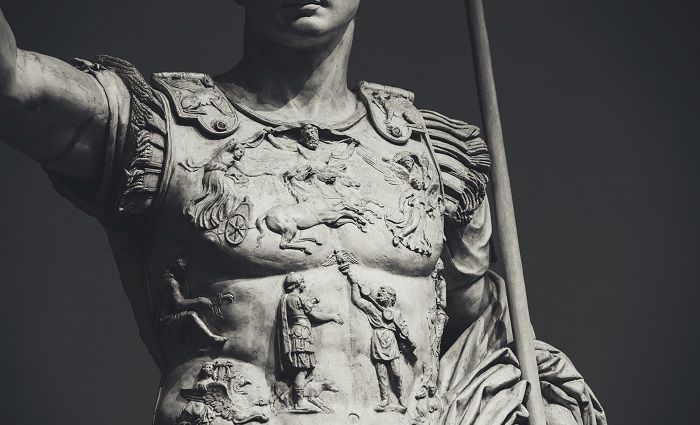
Unknown Artist | First Century A.D. | White Marble | New Wing
There are certain advantages to being the first—they are almost always remembered. Augustus was the first Emperor of the Roman Empire. He erased the chaos that had been destroying Rome more or less for the last century. Arguably, he increased the quality of life and made people want to live again.
This beautiful statue was found in 1863 in Prima Porta, a neighborhood on the outskirts of Rome today. Back in ancient times, it was the summer house of Augustus’ wife, Livia. Livia commissioned a sculpture of her husband as a military supreme commander, with gestures showing him speaking to his soldiers with great pride.
Filled with strength and intelligence, his face is captivating and makes us easily understand why not only Livia but also all of the women and men in Rome admired the emperor who had made Rome into a great and powerful empire
Enrico Bruschini, Art Historian and Official Vatican Tour Guide
15. Transfiguration
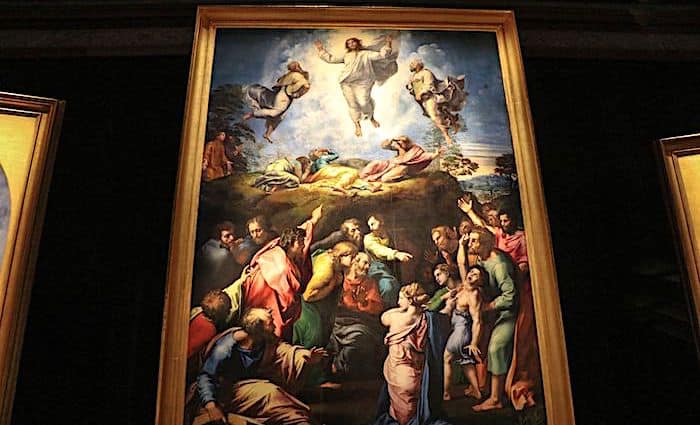
Raphael | 1518 – 1520 | Tempera on Wood | Pinacoteca Room VIII
This artwork was made specifically to be an altarpiece, so it would be up above our heads. Our eyes are naturally drawn to brighter colors, and Raphael played on this by gradually making the colors brighter the further up you look. In doing so, Raphael guides you on how to look at the scene. Start at the bottom and then work your way up to the top of the painting, culminating in Christ himself.
The painting depicts two stories from the Gospel according to Matthew. They are the Transfiguration and the meeting of the apostles with the obsessed youth who would be cured when Jesus returns from Mount Tabor.
The mastery of the painting is shown in numerous ways, so let’s start with the color. Raphael was famous for his use of vivid colors. Especially now, after the painting has been cleaned, we can see the colors the way Raphael and his contemporaries would have seen them.
This was Raphael’s last painting. Georgio Vasari, Raphael’s contemporary and biographer, called this painting “the most famous, most beautiful, and most divine.” It was supposedly laid over his tomb during his funeral. Unfortunately, Raphael died at the young age of 37, supposedly from syphilis. He was buried, and remains to this day, in the Pantheon in Rome.
Seeing his body dead, and his work so alive, it felt as if our heart would break in two.
Giorgio Vasari, Contemporary and Biographer of Raphael
14. The Annunciation
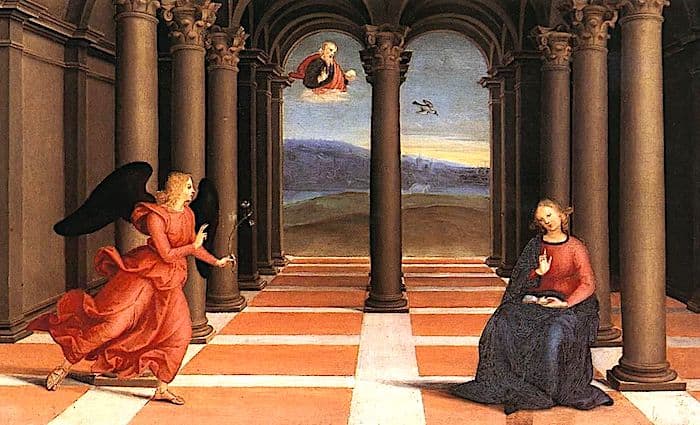
Raphael | 1502 – 1504 | Tempera on Wood | Pinacoteca Room VIII
Painted between the years 1502-1504, this is one of Raphael’s earliest works. It was commissioned for the Oddi family for their family chapel in Perugia.
The angel Gabriel approaches the Virgin Mary to let her know of the imminent coming of Jesus Christ (Annunciation). Mary sits by herself reading a book and seems to be expecting this moment. With ideal beauty reflected in her face, we see this even in the way she holds up her one hand welcoming the Angel.
In the background, you can see two arches that open up to a clear sky. One of Raphael’s trademarks was to add deep perspective in his paintings, which he does here with a light blue colored sky to show the most distant point.
You’ll also notice the 3D effect he creates with the columns and the dove in the distance. This painting resembles a very similar work by his teacher Perugino. Raphael would have studied under the Early-Renaissance master and, eventually, he achieved such mastery that many said they couldn’t tell the difference between master and student.
13. The Belvedere Torso
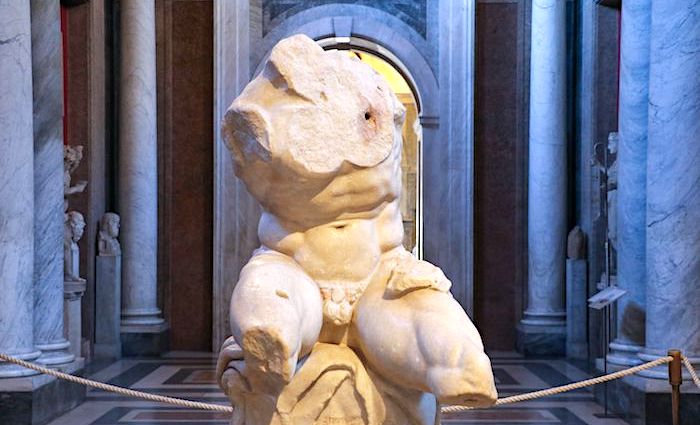
Apollonios | First Century B.C. | White Marble | Room of the Muses
Many are surprised when they walk into this room and find just a torso by itself. Why the heck did the Vatican feature a statue with no head, hands, or feet right in the middle of a room? In modern times, we take for granted all the resources we have to aid us in understanding anatomy.
The magic of this statue is that the body is in motion, contorting to his left, and all of his muscles complement that movement perfectly. This indicates that the sculptor had intimate knowledge of anatomy. This was a big deal even in the Renaissance period since it was forbidden to dissect humans to study muscles and anatomy.
This statue was found in the late 15th century and was in the Vatican collection by 1530. It would be a marble copy of an original bronze made sometime in the mid-second century B.C.
While the exact figure is unknown, many believe it to be Ajax contemplating his suicide after losing the competition with Odysseus from the Iliad. We do know the name of the sculptor because he engraved this statement on the statue: Apollonios, son of Nestor, the Athenian, created it.
Interesting Fact
Michelangelo displayed his admiration for this statue repeatedly in the Sistine Chapel. In the Chapel, the angels around each ceiling painting, are curving their bodies in the same direction as the torso.
In his Last Judgement, St. Bartholomew’s body also contorts to a degree in a similar fashion. In his twilight years, practically blind, he was said to visit the statue regularly and just run his hands over the muscles.
This is the work of a man who knew how to do it better than nature.
Michelangelo
12. Liberation Of St. Peter
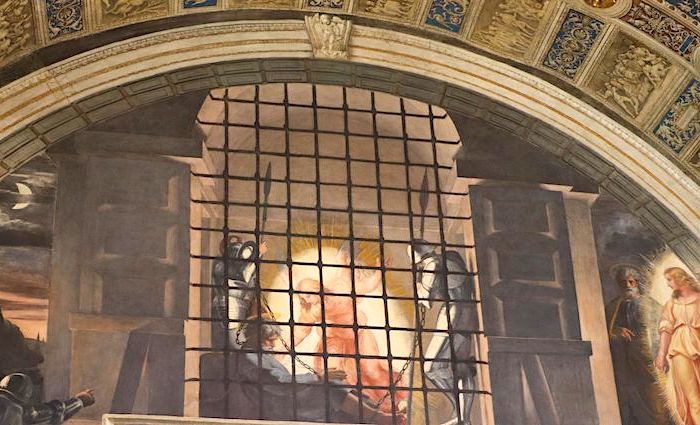
Raphael | 1512 | Fresco | Raphael Rooms: Room of Heliodorus
This entire fresco is a brilliant display of light effects. As you look closely at the painting, you’ll notice first the extreme splendor of the light of the angel herself whose glow reflects in the armor of the stunned prisoners in the room. Compare that with the light of the rising Sun to the left and also the natural light coming in from the window below.
Raphael was able to show, 500 years ago, how a room could be lit up in a painting. Besides the light, the robust colors used makes this painting shine. I remember walking into this room for the first time after it had been cleaned and the vibrance of colors was shocking!
Remember also that the medium used to paint this was fresco, which is unforgiving. You have to be fast and make no mistakes—a detail that makes this painting even more precious.
The story is about the first pope, St. Peter, who is a prisoner in Rome. In the evening, an angel comes and breaks his chains to set him free. Julius II commissioned this painting since, before becoming pope, he was the Titular Cardinal of St. Peter in Chains in Rome. In that church, you can still see the chains St. Peter wore that were broken by the angel.
Popular Vatican Tours

Best Selling Tour
Privileged Entrance Vatican Tour with Sistine Chapel
Without the right access, visiting the Vatican means fighting crowds, long waits, and missing the most significant rooms and works of art. Our privileged entrance tour offers more than just entry—it’s an immersive experience led by a storytelling guide who brings the Vatican to life. Skip the line and explore the Vatican Museums, including the Raphael Rooms, the Sistine Chapel, and St. Peter’s Basilica with engaging insights that make each moment memorable and meaningful.
See Prices

Exclusive Value
Exclusive Sistine Chapel After Hours Small Group Tour
The Vatican Museums are packed with crowds by day, but at night, they’re yours to explore. On this exclusive after-hours tour, step into the world’s most treasured collection after it has closed to the public. With a small group and expert guide, roam the Raphael Rooms, the Gallery of Maps, and Michelangelo’s Sistine Chapel without the chaos. This isn’t just a tour. It’s a once-in-a-lifetime privilege to experience the Vatican as few ever will!
See Prices
Not ready to book a tour? Check out our best Vatican tours to take and why.
11. Apoxyomenos
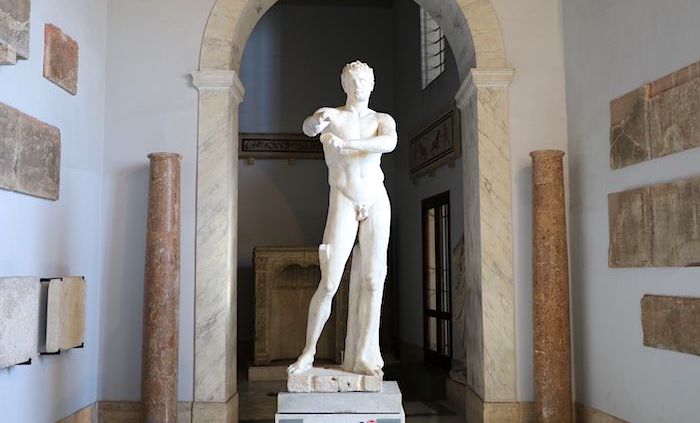
Unknown Artist | Original Fourth Century B.C. | White Marble | Room of the Apoxyomenos
How perfect would this statue be in a commercial for Bed, Bath, and Beyond? Apoxyomenos literally means “to clean oneself” and that is exactly what the portrayed athlete is doing.
Back in the day, athletes would clean themselves by rubbing oil into their skin, applying dust, and would scrape it off with a curved instrument called a strigil.
According to the Vatican Official Archives, “The statue is a Roman copy from around 50 A.D. of an original greek bronze sculpture by the great Lysippus from around 320 BC. Of particular note is the motion of his foot in the air and also the extension of the arm which creates space and gives depth to the sculpture”.
The Ancient Greeks knew about soap but limited it to washing clothes. Both ancient Greeks and Romans used to rub their skin with oil and pulverized pumice stone, then emove it using a strigil
Enrico Bruschini, Art Historian and Official Vatican Tour Guide
10. Crucifixion Of Saint Peter
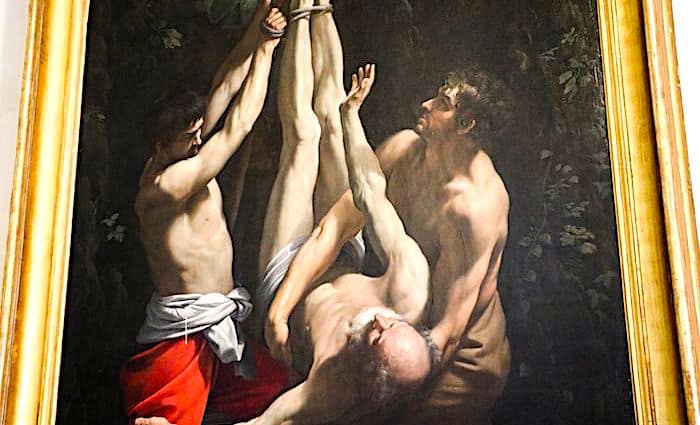
Guido Reni | 1604 – 1605 | Oil on Wood | Pinacoteca Room XII
It’s impossible not to speak about Caravaggio when you see this painting, whose influence on Guido Reni in this painting is undeniable. The first thing you notice is the real-life muscle tone of St. Peter.
You can see that there’s nothing idealized here and this could have been a real representation of what his body looked like. Next, you’ll notice there’s no perspective, so nothing is happening in the background—there’s only blackness. This allows you to focus 100% of your attention on the scene taking place.
St. Peter is being crucified for his Christian faith during the reign of Nero in A.D. 68. St. Peter didn’t feel worthy of the same death as Jesus and requested to be crucified upside down, depicted here.
This painting marks Guido Reni’s first success in Rome. It was commissioned for Cardinal Pietro Aldobrandini for the S. Paolo alle Tre Fontane church. Afterwards, it was sent to Paris like so much other artwork and eventually brought back to Rome in 1819 by Pius VII. It has remained in the Pinacoteca ever since.
Almost all of the painters of the day, and those who followed, were strongly influenced by Caravaggio’s use of new colors as well as by his new and powerful naturalism. No one has ever been able to imitate him, however.
Enrico Bruschini, Art Historian and Official Vatican Tour Guide
9. Martyrdom of St. Erasmus
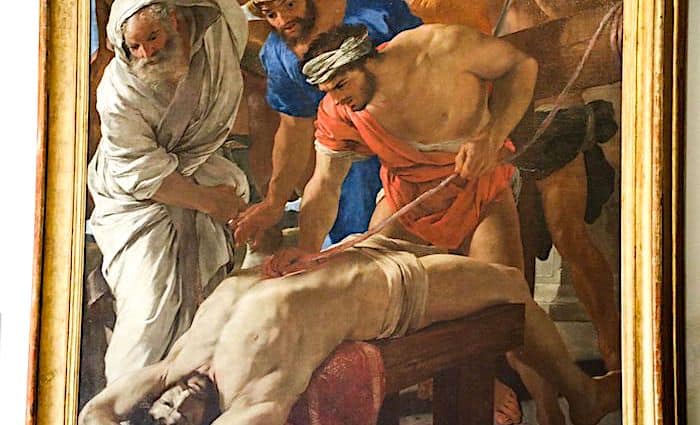
Nicolas Poussin | 1629 | Oil on Canvas | Pinacoteca Room XII
Nicolas Poussin (pronounced POOH-SAHN) was born in Normandy, France. However, he spent most of his life in Italy and was definitely Italian at heart. Like many, (myself included) once in Italy, the magical spell of this country trapped him. This dramatic painting is Nicolas Poussin’s first in Rome and not for the faint-hearted.
The painting depicts the martyrdom of St. Erasmus during the persecutions of Emperor Diocletian in A.D. 303. The future saint is stretched out with his hands behind his back, while the executioner pulls his intestines from his body and rolls them around a sailor’s capstan. Above him is a pagan priest pointing at a statue of Hercules that Erasmus refused to pray to. There are also angels coming down to him, offering him the palm and crown—both symbols of martyrdom.
Besides the graphic nature of the painting, Poussin used extremely vivid colors in this painting, especially white, blue, and red. At this point, we are at the height of baroque and also the realist movement started by Caravaggio (see below). Most people don’t know that this painting was actually commissioned to the painter Pietro da Cortona. However, it was then handed over to Poussin who even used the preparatory sketches made by da Cortona for the painting.
Intended for the altar in the right transept of St. Peter’s Basilica, the subject of the painting was chosen for the relics of the saint preserved there. Also taken to Paris and finally returned to Rome in 1820 by Pius VII, this painting found a home in the Pinacoteca where it remains to this day.
8. Deposition
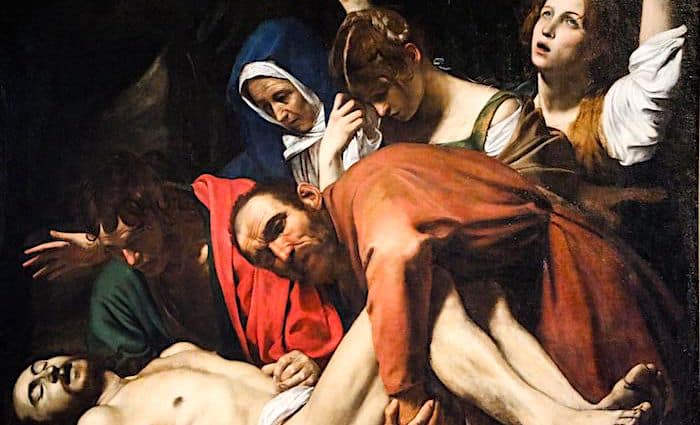
Caravaggio | 1604 | Oil on Canvas | Pinacoteca Room XII
Caravaggio may have been interesting company, but probably not someone you’d want to introduce to your family. His life was anything but usual. For example, he walked around Rome with a sword, was supposedly part of a local gang, and even killed a man in a duel.
As a result of the killing, he was forced to flee Rome and traveled south painting along the way from Naples to Sicily, Malta, and back. As the story goes, he was waiting for a pardon from Pope Urban VIII when one of his enemies finally caught up with him and killed him in Porto Ercole.
Up to this point in time, there were set templates dictating how to paint saints and holy people—to be painted with ideal beauty and purity. Caravaggio smashed these concepts by depicting them as ordinary people with defects. This revolutionary idea forever changed the art world. His impact on painters and painting in the 17th century with his realist trend is mind-boggling.
In one of Caravaggio’s greatest masterpieces, we see Jesus not being laid in the tomb, but on the anointing stone by Nicodemus and John. Close to him are the Virgin Mary, Mary Magdalene, and Mary of Cleophas who raises her arms and eyes towards heaven in prayer.
It’s an extremely pious moment with expressions of sadness on everyone’s faces. There is no perspective—only blackness—and you can see the muscles bulging from Nicodemus’ legs. There is nothing ideal expressed here except the extreme agony that everyone present is experiencing.
Why follow the manner of other artists when you can follow nature itself?
Michelangelo Merisi-Caravaggio
7. Apollo Belvedere
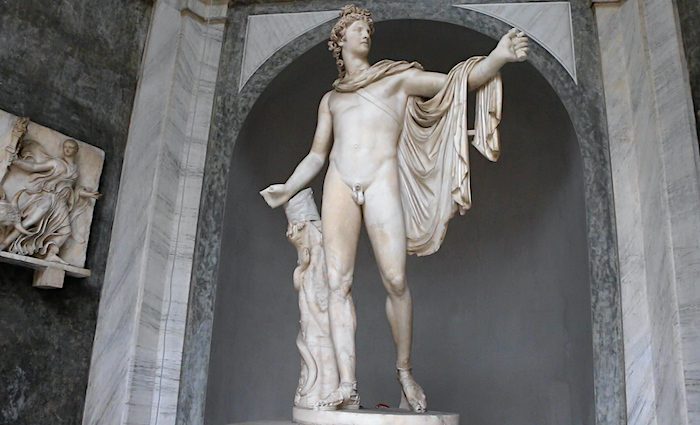
Unknown Artist | Second Century A.D. | White Marble | Octagonal Courtyard
The Apollo Belvedere arrived at the Vatican in 1508. It was owned by Pope Julius II before he was even pope. So, like many popes before him, he brought all his artwork with him into his new home, the Vatican, upon ascending to the purple. In the statue, the sun god Apollo has just let go of an arrow and is watching where it lands.
This particular statue is a Roman copy from the mid-second century A.D. of an original Greek bronze statue by Leochares from around 320 B.C. The exquisite hairstyle and flowing cape are remarkable details for that period. The Greek writer Pausanias wrote that this beautiful statue once adorned the Agora, Athen’s main square.
Interesting Fact
If you look closely at the face of Apollo, you will see a resemblance to Jesus Christ in the Last Judgement by Michelangelo who would have studied these statues and used them as inspiration for his own works.
Of all the works of antiquity that have escaped destruction, the statue of Apollo represents the highest ideal of art.
Johann Joachim Winckelmann, 18th-Century Art Historian
Popular Rome Tours

Best Selling Tour
Rome in a Day Tour with Colosseum and Vatican Museums
Seeing the best of Rome in a single day might seem like a big undertaking, but our expertly designed tour makes it effortless with skip-the-line tickets, included transportation, and engaging guides to lead the way. In just 7 hours, you’ll visit renowned sites like the Sistine Chapel, Colosseum, Trevi Fountain, and Pantheon. With fascinating stories at every stop, you can skip the stress and immerse yourself in the vibrant heritage and culture of Rome all in one remarkable day.
See Prices

Best Price!
Privileged Entrance Vatican Tour with Sistine Chapel
Without the right access, visiting the Vatican means fighting crowds, long waits, and missing the most significant rooms and works of art. Our privileged entrance tour offers more than just entry—it’s an immersive experience led by a storytelling guide who brings the Vatican to life. Skip the line and explore the Vatican Museums, including the Raphael Rooms, the Sistine Chapel, and St. Peter’s Basilica with engaging insights that make each moment memorable and meaningful.
See Prices
Not ready to book a tour? Check out our best Rome tours to take and why.
6. School 0f Athens
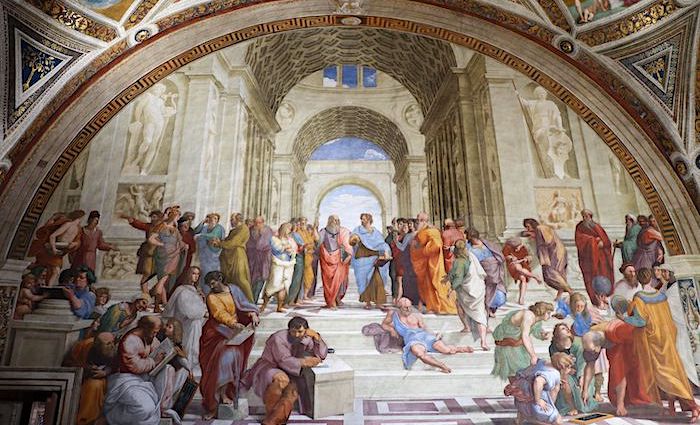
Raphael | 1508 – 1511 | Fresco | Raphael Rooms: Room of the Segnatura
The School of Athens is arguably one of the most famous paintings by Raphael due to its widespread use in textbooks. With this painting, he established himself as one of the most famous High Renaissance painters in the world. The painting, for our purposes, is actually famous for two reasons.
Firstly, it is harmonious, symmetrical, and celebrates ideal beauty in all its forms, which was important in Renaissance paintings. Secondly, this painting is basically a yearbook of the most famous artists of the early 15th century. Raphael used the faces of his friends as models for some of the famous people:
- Leonardo Da Vinci is Plato pointing a finger in the air.
- Bramante is Euclid, bending over a chalkboard.
- Raphael puts himself in the painting on the far right side staring directly at us.
According to legend, while Raphael was painting this room, Michelangelo was painting the Sistine Chapel. One day, he got a peek of what Michelangelo was doing and was so impressed that he came back upstairs and broke a piece of plaster off the wall and painted the face of Michelangelo as a tribute to how good he was.
Raphael saw the frescoes of Michelangelo and changed style.
Giorgio Vasari, Raphael’s Contemporary and Biographer
5. Faun with the Infant Dionysius
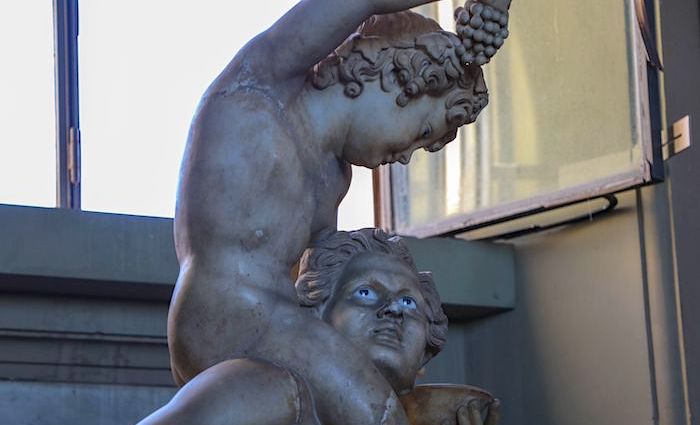
Unknown Artist | Unknown Date | White Marble | Gallery of the Candelbra
Did you know that ancient statues had eyes? While this may seem like a crazy idea, take a look at the photo above. You’ll see that the Faun and infant Dionysius have glass eyes. While strange to us today, adding eyes made the statue much more life-like.
Ancient statues were also painted. When you see this statue in person, take a close look at the hair of infant Dionysius. There, you’ll see paint remnants.
The paints used were natural colors and after two thousand years beneath the earth or under the rain and sun these have disappeared for the most part.
Enrico Bruschini, Art Historian and Official Vatican Tour Guide
4. St. Matthew
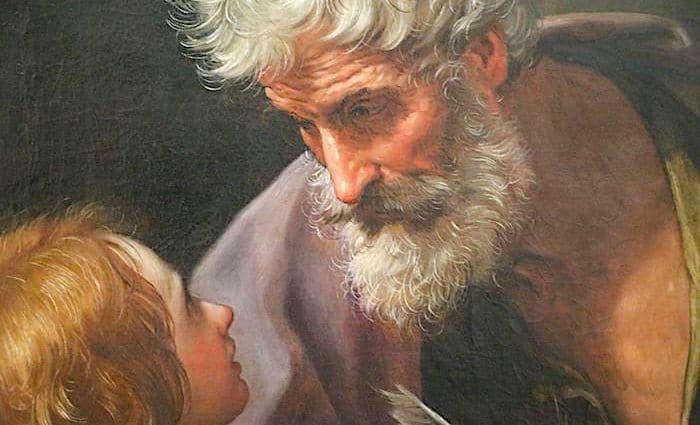
Guido Reni | 1635 – 1640 | Oil on Canvas | Pinacoteca Room XII
Sometimes, you see a piece of artwork and it just mesmerizes you. The intensity of the gaze and connection between these two figures is the most profound I have ever found in a painting. Stand in front of this painting in real life at the Vatican Museums and see if it has the same effect on you.
This piece shows the Apostle Matthew as he takes a break from his writing to look at an angel. Gone are the days of ideal beauty and deep perspective from the High Renaissance as we look at this masterpiece. As a result, the apostle has been depicted as an old man we would recognize today, with wrinkles on his forehead, disheveled hair, and straining veins in the neck. The angel has rosy cheeks and an almost anemic look that you could find in many boys today.
The magic is the inaction itself. Neither of them is speaking. The angel looks up at St. Matthew in a loving manner who returns the look of affection with his own loving gaze. If this scene was taken out of context, you would simply imagine a painting of a grandfather and grandson expressing their love for each other. They don’t need to speak; they understand each other perfectly.
3. Laocoön Group
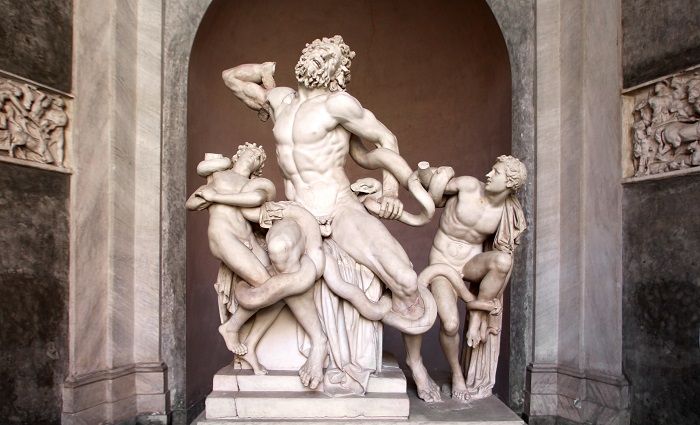
Hagesandros | First Century A.D. | White Marble | Octagonal Room
If you’re a Star Wars fan, the Laocoön might remind you of Han Solo when he was frozen in carbon for Jabba the Hut. The sculptor was able to capture the precise moment of agony.
The statue was discovered on Esquiline Hill in 1506 and Pope Julius II was immediately informed. It is believed to be an original Greek statue made around 40 B.C. Once uncovered, they identified the statue right away as the Laocoön Group of statues made by sculptors on the island of Rhodes.
This work represents a story from the “Aeneid” by Virgil. In the story, the Trojans believed the war to be over when they received the Trojan horse from the Greeks. The priest Laocoön was the exception and warned that the horse would be their downfall. Athena, who sided with the Greeks, sent two serpents to kill the priest and his two sons, quieting them forever. The rest is history.
Interesting Fact
When they found the statue, it was missing its right arm. Many artists made their own renditions of the arm, depicting it pointing straight up in the air. Michelangelo looked at the body movement and realized that the arm should be bent.
A Swedish archeologist discovered the original arm in the 17th century, and guess what it looked like? The arm bent just as Michelangelo had imagined it. Supposedly, the museum connected Michelangelo’s arm to the back of the statue and it’s still there today. But this remains to be confirmed.
Popular Vatican Tours

Best Selling Tour
Privileged Entrance Vatican Tour with Sistine Chapel
Without the right access, visiting the Vatican means fighting crowds, long waits, and missing the most significant rooms and works of art. Our privileged entrance tour offers more than just entry—it’s an immersive experience led by a storytelling guide who brings the Vatican to life. Skip the line and explore the Vatican Museums, including the Raphael Rooms, the Sistine Chapel, and St. Peter’s Basilica with engaging insights that make each moment memorable and meaningful.
See Prices

Exclusive Value
Exclusive Sistine Chapel After Hours Small Group Tour
The Vatican Museums are packed with crowds by day, but at night, they’re yours to explore. On this exclusive after-hours tour, step into the world’s most treasured collection after it has closed to the public. With a small group and expert guide, roam the Raphael Rooms, the Gallery of Maps, and Michelangelo’s Sistine Chapel without the chaos. This isn’t just a tour. It’s a once-in-a-lifetime privilege to experience the Vatican as few ever will!
See Prices
Not ready to book a tour? Check out our best Vatican tours to take and why.
2. The Last Judgement
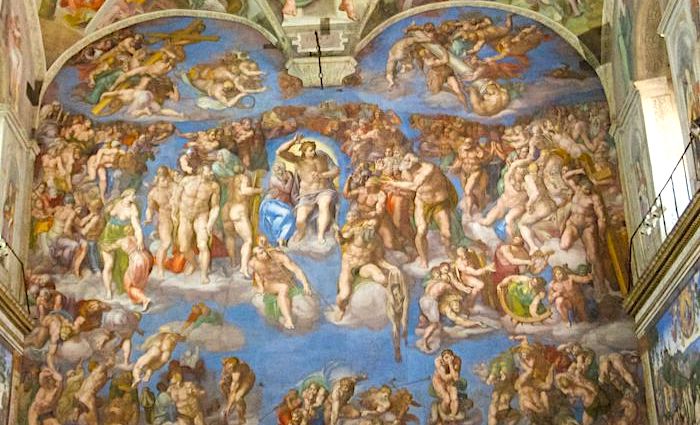
Michelangelo | 1536 – 1541 | Fresco | Sistine Chapel
Picture any 61-year-old man you know and imagine them painting a 42-foot high and 39-foot long wall for the next five years. On top of that, they would need to be able to produce a painting that would be described as one of the best ever created in the history of man. I don’t personally know any 61-year olds who could do that today. This is why Michelangelo is arguably the greatest of all time.
In the Last Judgement, all of the sinners will be sent down to Hell’s eternal fire and all of those who believe and repent will be allowed to enter the Kingdom of Heaven. The world is ending at this point and Michelangelo portrays this perfectly, adding many elements of classic literature as well.
The Top
In the upper lunettes, angels are carrying instruments used during the Passion of Christ (the cross, the whip, the column he was whipped on, and the crown of thorns). Below, an extremely muscular Jesus with no beard in a powerful position is presiding over the entire scene with a radiant halo bursting behind him. Recognizable figures include John the Baptist, the Virgin Mary, St. Peter holding the keys, and various other saints holding in their hands the instrument they were martyred with.
The Middle
Below, there is a group of angels blowing trumpets and holding two books that decide their fate—ascend to heaven or descend to hell. Those redeemed ascend from their graves while the condemned descend into the underworld.
The Bottom
Here, Michelangelo alludes to Greek mythology with the demon (Charon) on a boat who brings all the souls of the damned to the underworld. On the far right side, you will see the Devil himself and all the damned and lost souls behind him in Hell.
Interesting Facts
When the painting was unveiled, many were shocked by the amount of nudity in the painting. Cardinal Biagio da Cesena said that this was better suited for a tavern than the holy chapel of the pope. It is said that Michelangelo then replaced the face of the devil with that of the cardinal, wrapping a snake around his body and biting him in the groin area.
Below Jesus, you’ll find St. Bartholomew who was skinned alive. He holds a knife in his right hand and his own skin in his left. Many contemporaries suggested that Michelangelo did a self-portrait in the skin!
If people knew how hard I worked to get my mastery, it wouldn’t seem so wonderful at all
Michelangelo
1. The Sistine Chapel Ceiling
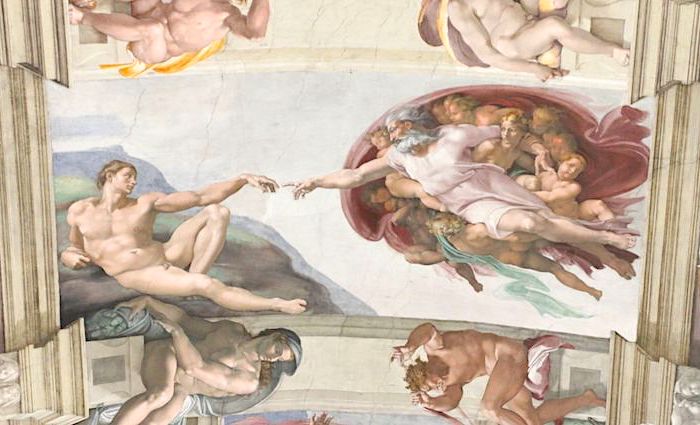
Michelangelo | 1508 – 1512 | Fresco | Sistine Chapel
Julius’ decision to repaint the ceiling probably had to do with structural damage caused during the excavations for the Borgia Tower and the new St. Peter’s Basilica. At the time, Michelangelo was working on the pope’s tomb and seemed to be quite content with this.
As the story goes, Bramante, who was upset with Michelangelo for a previous slight, suggested to the pope that Michelangelo should paint the ceiling even though he was a sculptor and not a painter. Julius agreed and Michelangelo, pretty much against his will, signed the contract to paint the ceiling.
The original design was to be the twelve apostles. However, after Michelangelo objected, Julius put the design in the master’s hands and the rest is history. Michelangelo had many problems/hardships going into this job. For example:
- He was a sculptor, not a painter.
- Having never really painted in this medium, his first attempt at fresco painting basically resulted in the most famous painting in the world.
- He had to build his own scaffolding before he could even reach the ceiling, which was 60 feet high.
- Since he was a perfectionist, he basically painted the entire thing by himself.
- There was no centralized heating, so he complained of stifling heat in the summer and numbing cold in the winter.
- He developed an eye disease during the painting, which only went away once he finished the ceiling years later.
The Ceiling
The ceiling is broken down into Central Panels, Sibyls and Prophets, Christ’s forefathers, and four corner stories. The heart of the ceiling is the nine central panels with arguably the most recognizable painting in the world—the Creation of Man panel. These central panels are:
- Separation of Light from Darkness
- Creation of the sun, moon, and planets
- Separation of Land from Sea
- Creation of Man
- Creation of Eve from the Body of Adam
- Banishment from the Garden of Eden
- The Sacrifice of Noah
- The Flood
- The Drunkenness of Noah
I cannot tell you how much I wished you were here, for until you have seen the Sistine Chapel, you can have no adequate conception of what man is capable of accomplishing.
Johann Wolfgang von Goethe
Speaking of Michelangelo—Did you know that when Michelangelo painted his masterpiece in the Sistine Chapel, he only ever imagined a small group of people seeing it, not droves of tourists. But overcrowded Vatican tours have changed that.
That is, until now. Our Exclusive Sistine Chapel After Hours Small Group Tour allows you to see the Sistine Chapel the way Michelangelo intended you to see it—alone, without the tourists, and in peaceful contemplation.
Not ready to book a tour? Find out if a Vatican tour is worth it.
Here is Where to Stay in the Most Popular Destinations
Rome, Florence, Venice, and the Amalfi Coast and Capri

